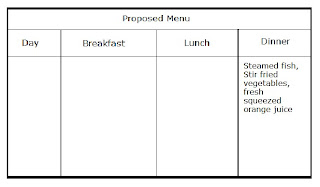Some people find it difficult to budget, that is whey we have this article for our reader: How to Budget for Food. Everyday we ask the question: “What shall we eat today?” This question can become quite nagging for the one responsible for preparing the meals at home. It can also be quite a burden on that person. They are responsible for providing the main source of fuel for the family members while making it a delicious meal at the same time. Similar to budgeting for the household, food budgeting requires personal honesty and commitment. Other than that, it is quite simple. In this article we will discuss how to budget for food and draw up a food budget.
Steps: How to Budget For Food
The Nutritive Needs
First consider the average nutritive needs of your individual family members in relation to their daily activities. It is a good idea to write down on paper all these ideas. Figure 1 shows an example of writing up a needs assessment of family members. Required calorie intake is a rough estimate that would take into consideration your age, weight, height, your level of daily activity, and your body composition. The column marked “Other Information” refers to other needs you need to remember for that family member. One of the members in the family may require a special diet, or may be allergic to some foods.
Figure 1. Family Members Needs Assessment Table

Allocate a Total Cost to Food
Then consider the allocated total food cost towards food. This varies, but on an average the typical family, middle and lower income family, allocates 1/4 of their income to the purchase of food. Some families may be receiving assistance in some form of the other through social welfare. the value that is received for food is also considered.
Selecting Nutritive Foods
Next, it is up to the planner to choose the food with the optimum nutritive value that can satisfy the needs of the family. For instance, milk is economical in cost as well as a good source calcium. It is now a good idea to list the the various items that the family needs on a daily basis (figure 2). You can go through each food group to help you form your list. The food groups are: grains, vegetables, fruits, milk, meat and beans. (Note that oil is not classified as a food group, yet it is part of the food list). From this list, if you include quantities, you can do a check and balance if you like. Estimate the total calorie of food from the list for one day and compare it to the total calorie intake for the family for one day.
Figure 2.

Plan Meals
Next, the meals should be planned in advance (See figure 3). If dinner is most important to your family, you start with dinner first. You can use the meat or substitute meat (as in case of a vegetarian) to begin your menu. Then you continue with the menu for breakfast and lunch. Make sure you include snacks taken after meals. Here are some general points you need to follow when planning your meals:
1. Standardize the meals to be served.
Once families determine their needs according to their physical activities they can begin to plan their meals. If the family is an extremely active family, the father engages in a lot of manual labour, the children are involved in a lot of sport, and the mother is very busy with work or other activities throughout the day, the meals served for breakfast and lunch will be varied and dense in calories and protein.
2. Each meal should have at least one hot dish.
This aids in digestion. Therefore, you may have your bake or bread with a hot cup of cocoa tea.
3. Carbohydrate foods of same colour and texture should be serve one at a time, not together.
Rice, flour, and potato have similar mild taste, same colour and texture and therefore should not be placed in the same serving.
4. Carefully plan food combinations.
Foods that are difficult to digest should be eaten with food that are easily digested. Therefore, dishes that include large amounts of fat and protein, such as pork, should be combined or eaten with simple digestion food, such as salads, and fruits. It would not go well with fries.
5. Plan your meal one day at a time or week at a time.
This ensures there are variations in the meal. This way you will be able to keep the seasons in mind, your available storage facilities, and the cost of food.
Figure 3. An example of a proposed menu.

Grocery List
Finally, your final list comes from the proposed menu. You can choose to budget your food on a weekly, fortnightly, or monthly basis. Estimate the total cost of the meals and compare it to your income. If the cost is equivalent to what you wish to be allocated for food from your income you can be satisfied with the list. However, if the cost seems excessive, beyond the allocated cost of income, you will have to go over the steps again and look for items that can be substituted with equally cheaper and nutritive items.
Figure 4: Estimated meals for the week/fortnight/month

As you can see drawing up a simple food budget can be tedious, but once the basics are done, drawing up your grocery list can be quite easy. Why don’t you try it with your next budget!
Back to Articles
Don’t forget to leave your comments for “How to budget for food” in the comment box below.

